Stress Evaluation in Simulated Autonomous and Manual Driving through the Analysis of Skin Potential Response and Electrocardiogram Signals
Abstract
:1. Introduction
2. Methods
2.1. Signals Processing
2.2. Features Engineering and Machine Learning
3. Experimental Setup
4. Results
4.1. Results Considering the SPR Signal Only
4.2. SPR Classification Algorithm Results
4.3. ECG Results
5. Discussion and Conclusions
Author Contributions
Funding
Acknowledgments
Conflicts of Interest
Abbreviations
| SPR | Skin Potential Response |
| EDA | Electrodermal Activity |
| ECG | Electrocardiogram |
| MA | Motion Artifact |
| ML | Machine Learning |
| SVM | Support Vector Machine |
References
- Chowdhury, A.; Shankaran, R.; Kavakli, M.; Haque, M.M. Sensor applications and physiological features in drivers’ drowsiness detection: A review. IEEE Sens. J. 2018, 18, 3055–3067. [Google Scholar] [CrossRef]
- Baltodano, S.; Garcia-Mancilla, J.; Ju, W. Eliciting driver stress using naturalistic driving scenarios on real roads. In Proceedings of the 10th International Conference on Automotive User Interfaces and Interactive Vehicular Applications, Toronto, ON, Canada, 23–25 September 2018; pp. 298–309. [Google Scholar]
- Bitkina, O.V.; Kim, J.; Park, J.; Park, J.; Kim, H.K. Identifying traffic context using driving stress: A longitudinal preliminary case study. Sensors 2019, 19, 2152. [Google Scholar] [CrossRef] [PubMed] [Green Version]
- Rastgoo, M.N.; Nakisa, B.; Rakotonirainy, A.; Chandran, V.; Tjondronegoro, D. A critical review of proactive detection of driver stress levels based on multimodal measurements. ACM Comput. Surv. (CSUR) 2019, 51, 1–35. [Google Scholar] [CrossRef] [Green Version]
- Kundu, T.; Saravanan, C. Advancements and recent trends in emotion recognition using facial image analysis and machine learning models. In Proceedings of the 2017 International Conference on Electrical, Electronics, Communication, Computer, and Optimization Techniques (ICEECCOT), Mysuru, India, 15–16 December 2017; pp. 1–6. [Google Scholar]
- Ishii, Y.; Ogitsu, T.; Takemura, H.; Mizoguchi, H. Real-time eyelid open/closed state recognition based on HLAC towards driver drowsiness detection. In Proceedings of the 2014 IEEE International Conference on Robotics and Biomimetics (ROBIO 2014), Bali, Indonesia, 5–10 December 2014; pp. 2449–2454. [Google Scholar]
- Fan, X.A.; Bi, L.Z.; Chen, Z.L. Using EEG to detect drivers’ emotion with Bayesian Networks. In Proceedings of the 2010 International Conference on Machine Learning and Cybernetics, Qingdao, China, 11–14 July 2010; Volume 3, pp. 1177–1181. [Google Scholar]
- Yu, Y.J.; Yang, Z.; Oh, B.S.; Yeo, Y.K.; Liu, Q.; Huang, G.B.; Lin, Z. Investigation on driver stress utilizing ECG signals with on-board navigation systems in use. In Proceedings of the 2016 14th International Conference on Control, Automation, Robotics and Vision (ICARCV), Phuket, Thailand, 13–15 November 2016; pp. 1–6. [Google Scholar]
- Tomoi, D.; Wen, W.; Yamakawa, H.; Hamasaki, S.; Takakusaki, K.; An, Q.; Tamura, Y.; Yamashita, A.; Asama, H. Estimation of stress during car race with factor analysis. In Proceedings of the 2015 International Symposium on Micro-NanoMechatronics and Human Science (MHS), Nagoya, Japan, 23–25 November 2015; pp. 1–5. [Google Scholar]
- Katsis, C.D.; Katertsidis, N.; Ganiatsas, G.; Fotiadis, D.I. Toward emotion recognition in car-racing drivers: A biosignal processing approach. IEEE Trans. Syst. Man Cybern.-Part A Syst. Hum. 2008, 38, 502–512. [Google Scholar] [CrossRef]
- Rigas, G.; Goletsis, Y.; Bougia, P.; Fotiadis, D.I. Towards driver’s state recognition on real driving conditions. Int. J. Veh. Technol. 2011, 2011. [Google Scholar] [CrossRef] [Green Version]
- Rigas, G.; Goletsis, Y.; Fotiadis, D.I. Real-time driver’s stress event detection. IEEE Trans. Intell. Transp. Syst. 2011, 13, 221–234. [Google Scholar] [CrossRef]
- Lanatà, A.; Valenza, G.; Greco, A.; Gentili, C.; Bartolozzi, R.; Bucchi, F.; Frendo, F.; Scilingo, E.P. How the autonomic nervous system and driving style change with incremental stressing conditions during simulated driving. IEEE Trans. Intell. Transp. Syst. 2014, 16, 1505–1517. [Google Scholar] [CrossRef]
- Lee, D.S.; Chong, T.W.; Lee, B.G. Stress events detection of driver by wearable glove system. IEEE Sens. J. 2016, 17, 194–204. [Google Scholar] [CrossRef]
- Panicker, S.S.; Gayathri, P. A survey of machine learning techniques in physiology based mental stress detection systems. Biocybern. Biomed. Eng. 2019. [Google Scholar] [CrossRef]
- Mălăescu, A.; Duţu, L.C.; Sultana, A.; Filip, D.; Ciuc, M. Improving in-car emotion classification by NIR database augmentation. In Proceedings of the 2019 14th IEEE International Conference on Automatic Face & Gesture Recognition (FG 2019), Lille, France, 14–18 May 2019; pp. 1–5. [Google Scholar]
- Lee, B.G.; Chong, T.W.; Lee, B.L.; Park, H.J.; Kim, Y.N.; Kim, B. Wearable mobile-based emotional response-monitoring system for drivers. IEEE Trans. Hum.-Mach. Syst. 2017, 47, 636–649. [Google Scholar] [CrossRef]
- Choi, M.; Koo, G.; Seo, M.; Kim, S.W. Wearable device-based system to monitor a driver’s stress, fatigue, and drowsiness. IEEE Trans. Instrum. Meas. 2017, 67, 634–645. [Google Scholar] [CrossRef]
- Halim, Z.; Rehan, M. On identification of driving-induced stress using electroencephalogram signals: A framework based on wearable safety-critical scheme and machine learning. Inf. Fusion 2020, 53, 66–79. [Google Scholar] [CrossRef]
- Harb, M.; Xiao, Y.; Circella, G.; Mokhtarian, P.L.; Walker, J.L. Projecting travelers into a world of self-driving vehicles: Estimating travel behavior implications via a naturalistic experiment. Transportation 2018, 45, 1671–1685. [Google Scholar] [CrossRef]
- Gold, C.; Körber, M.; Lechner, D.; Bengler, K. Taking over control from highly automated vehicles in complex traffic situations: The role of traffic density. Hum. Fact. 2016, 58, 642–652. [Google Scholar] [CrossRef] [PubMed]
- Zang, S.; Ding, M.; Smith, D.; Tyler, P.; Rakotoarivelo, T.; Kaafar, M.A. The Impact of Adverse Weather Conditions on Autonomous Vehicles: How Rain, Snow, Fog, and Hail Affect the Performance of a Self-Driving Car. IEEE Veh. Technol. Mag. 2019, 14, 103–111. [Google Scholar] [CrossRef]
- Feldhütter, A.; Gold, C.; Schneider, S.; Bengler, K. How the duration of automated driving influences take-over performance and gaze behavior. In Advances in Ergonomic Design of Systems, Products and Processes; Springer: Berlin, Germany, 2017; pp. 309–318. [Google Scholar]
- Manabu, O.; Fujioka, T.; Hashimoto, N.; Shimizu, H. The application of RTK-GPS and steer-by-wire technology to the automatic driving of vehicles and an evaluation of driver behavior. IATSS Res. 2006, 30, 29–38. [Google Scholar]
- Feldhütter, A.; Segler, C.; Bengler, K. Does shifting between conditionally and partially automated driving lead to a loss of mode awareness. In International Conference on Applied Human Factors and Ergonomics; Springer: Berlin, Germany, 2017; pp. 730–741. [Google Scholar]
- Jarosch, O.; Bellem, H.; Bengler, K. Effects of Task-Induced Fatigue in Prolonged Conditional Automated Driving. Hum. Fact. 2019, 61, 1186–1199. [Google Scholar] [CrossRef] [PubMed]
- Pomarjanschi, L.; Dorr, M.; Rasche, C.; Barth, E. Safer driving with gaze guidance. In Proceedings of the International Conference on Bio-Inspired Models of Network, Information, and Computing Systems, Boston, MA, USA, 1–3 December 2010; pp. 581–586. [Google Scholar]
- Xia, Y.; Zhang, D.; Kim, J.; Nakayama, K.; Zipser, K.; Whitney, D. Predicting driver attention in critical situations. In Proceedings of the Asian Conference on Computer Vision, Perth, Australia, 2–6 December 2018; pp. 658–674. [Google Scholar]
- Bosch, E.; Oehl, M.; Jeon, M.; Alvarez, I.; Healey, J.; Ju, W.; Jallais, C. Emotional GaRage: A Workshop on In-Car Emotion Recognition and Regulation. In Proceedings of the Adjunct Proceedings of the 10th International Conference on Automotive User Interfaces and Interactive Vehicular Applications, Toronto, ON, Canada, 23–25 September 2018; pp. 44–49. [Google Scholar]
- Park, C.; Shahrdar, S.; Nojoumian, M. EEG-based classification of emotional state using an autonomous vehicle simulator. In Proceedings of the 2018 IEEE 10th Sensor Array and Multichannel Signal Processing Workshop (SAM), Sheffield, UK, 8–11 July 2018; pp. 297–300. [Google Scholar]
- Affani, A.; Zontone, P.; Fenici, R.; Brisinda, D.; Bacchin, D.; Gamberini, L.; Pluchino, P.; Bruschetta, M.; Savorgnan, C.; Minen, M.; et al. Assisted/autonomous vs. human driving assessment on the DiM driving simulator using objective/subjective characterization. In Proceedings of the 10th International Munich Chassis Symposium 2019, Munich, Germany, 25–26 June 2019; pp. 307–321. [Google Scholar]
- VI-grade Srl. Available online: https://www.vi-grade.com (accessed on 20 April 2020).
- Taggart, P.; Gibbons, D.; Somerville, W. Some effects of motor-car driving on the normal and abnormal heart. Br. Med. J. 1969, 4, 130–134. [Google Scholar] [CrossRef] [PubMed] [Green Version]
- Affanni, A.; Piras, A.; Rinaldo, R.; Zontone, P. Dual channel Electrodermal activity sensor for motion artifact removal in car drivers’ stress detection. In Proceedings of the 2019 IEEE Sensors Applications Symposium (SAS), Sophia Antipolis, France, 11–13 March 2019; pp. 1–6. [Google Scholar]
- Zontone, P.; Affanni, A.; Bernardini, R.; Piras, A.; Rinaldo, R.; Formaggia, F.; Minen, D.; Minen, M.; Savorgnan, C. Car Driver’s Sympathetic Reaction Detection through Electrodermal Activity and Electrocardiogram Measurements. IEEE Trans. Biomed. Eng. 2020, 1–12. [Google Scholar] [CrossRef] [PubMed]
- Schiessl, C. Stress and strain while driving. In Proceedings of the Young Researchers Seminar-European Conference of Transport Research Institutes, Brno, Czech Republic, 27–30 May 2007; pp. 1–11. [Google Scholar]
- Zontone, P.; Affanni, A.; Bernardini, R.; Piras, A.; Rinaldo, R. Low-Complexity Classification Algorithm to Identify Drivers’ Stress Using Electrodermal Activity (EDA) Measurements. In Biomedical Engineering and Computational Intelligence; Springer International Publishing: Berlin, Germany, 2020; pp. 25–33. [Google Scholar]
- Affanni, A. Wearable instrument to measure simultaneously cardiac and electrodermal activities. In Proceedings of the 2016 IEEE International Symposium on Medical Measurements and Applications, MeMeA 2016, Benevento, Italy, 12–14 May 2016. [Google Scholar]
- Affanni, A. Dual channel electrodermal activity and an ECG wearable sensor to measure mental stress from the hands. ACTA IMEKO 2019, 8, 56–63. [Google Scholar] [CrossRef]
- Zontone, P.; Affanni, A.; Bernardini, R.; Piras, A.; Rinaldo, R. Stress Detection Through Electrodermal Activity (EDA) and Electrocardiogram (ECG) Analysis in Car Drivers. In Proceedings of the 2019 27th European Signal Processing Conference (EUSIPCO), A Coruña, Spain, 2–6 September 2019. [Google Scholar]
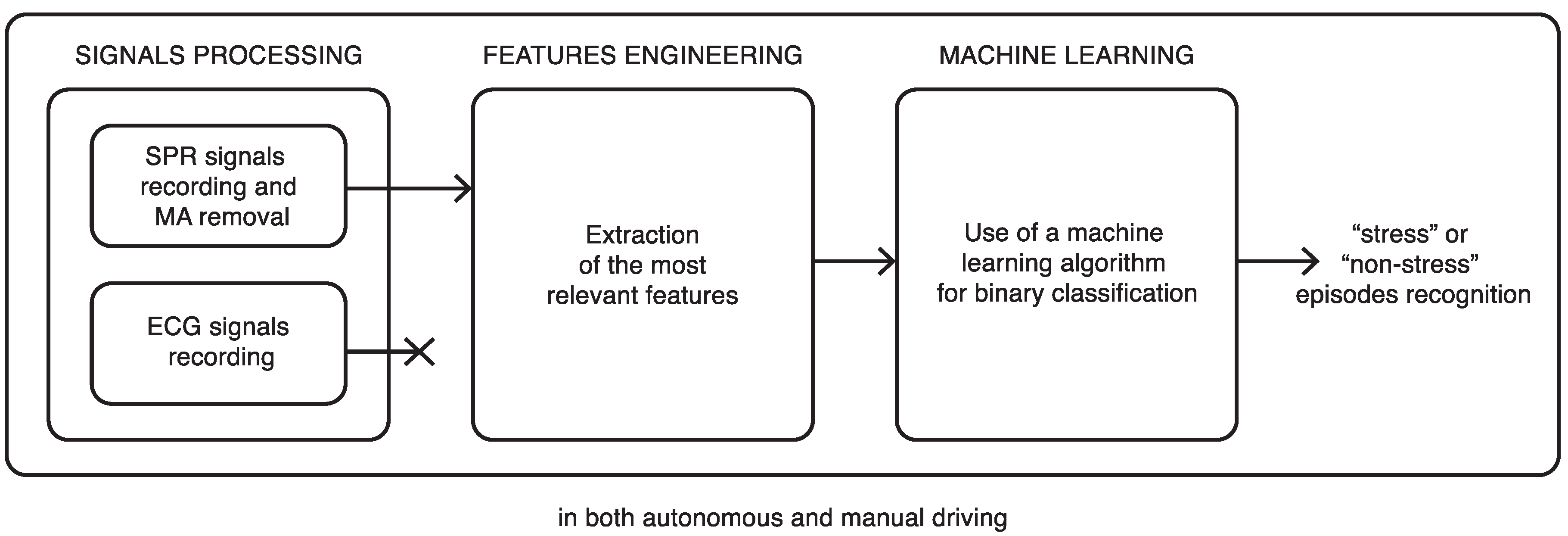
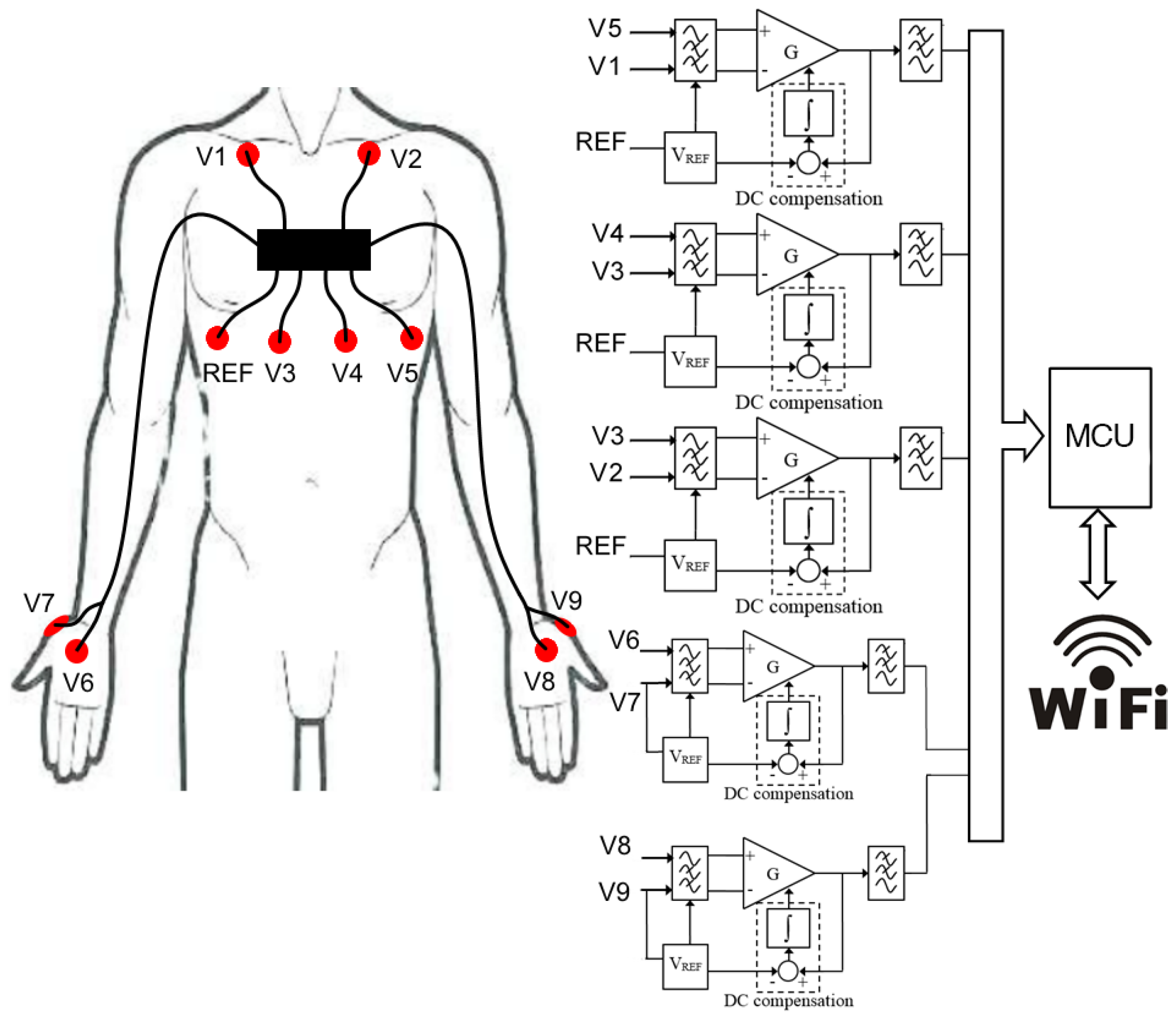



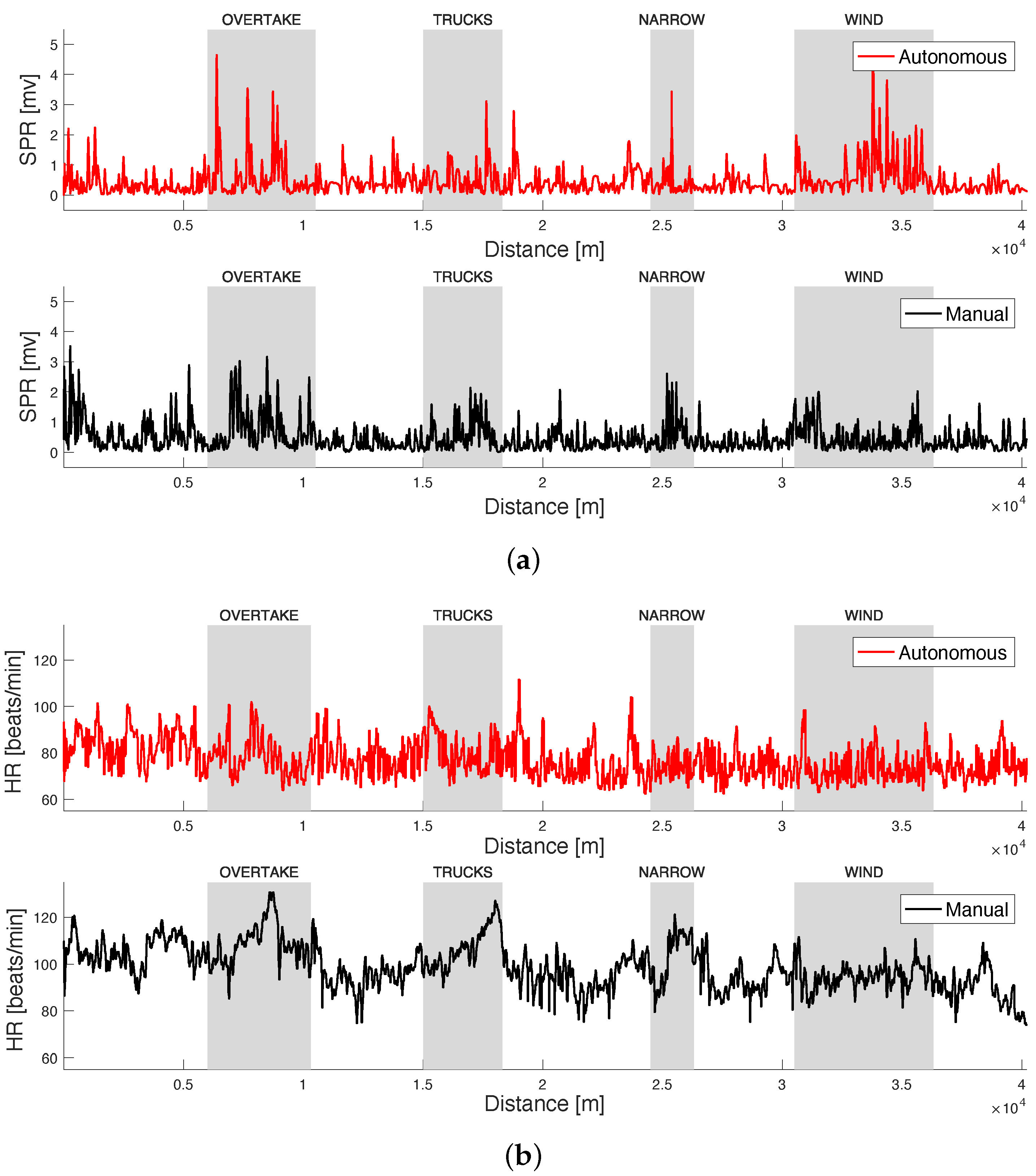
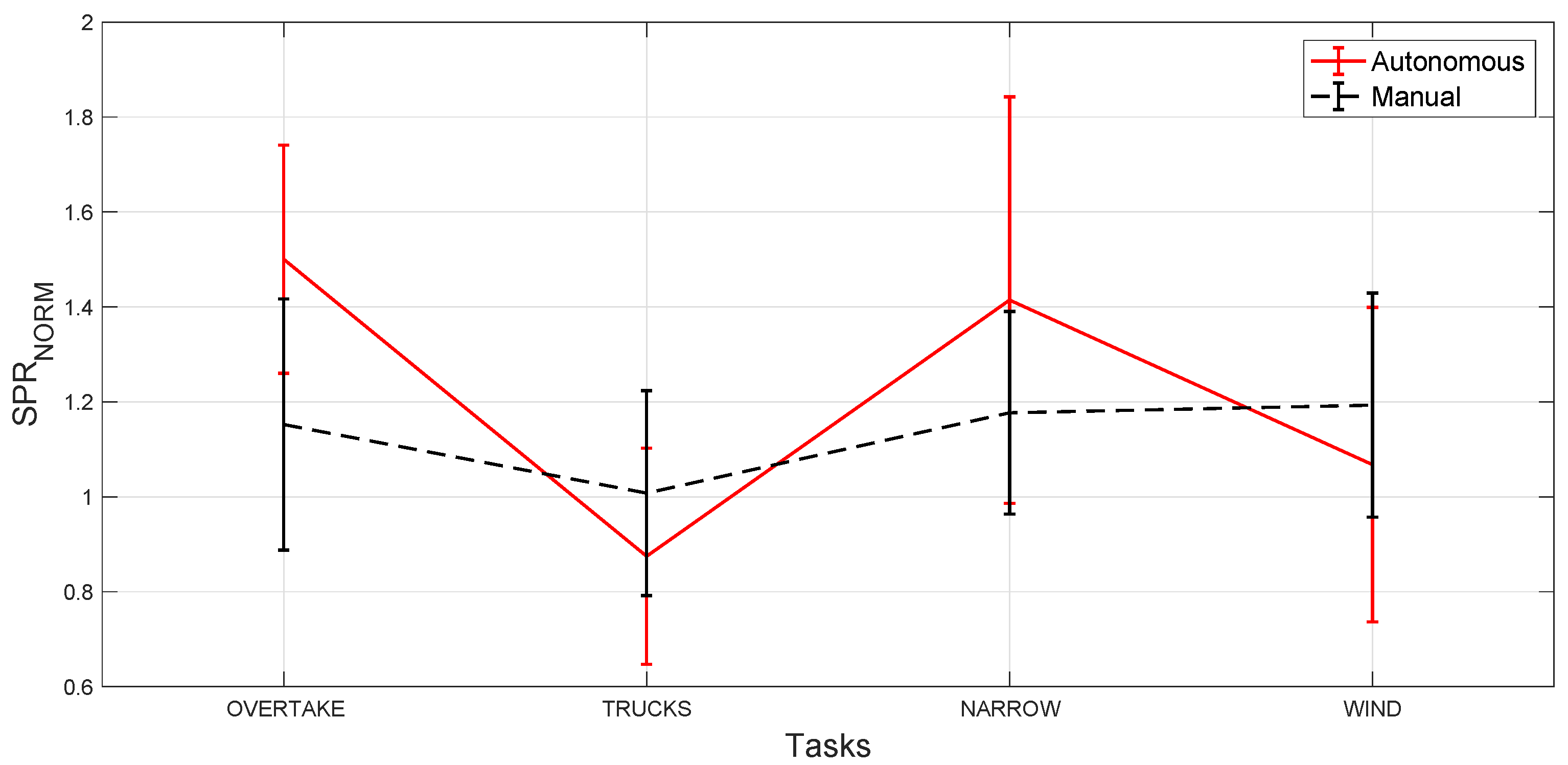


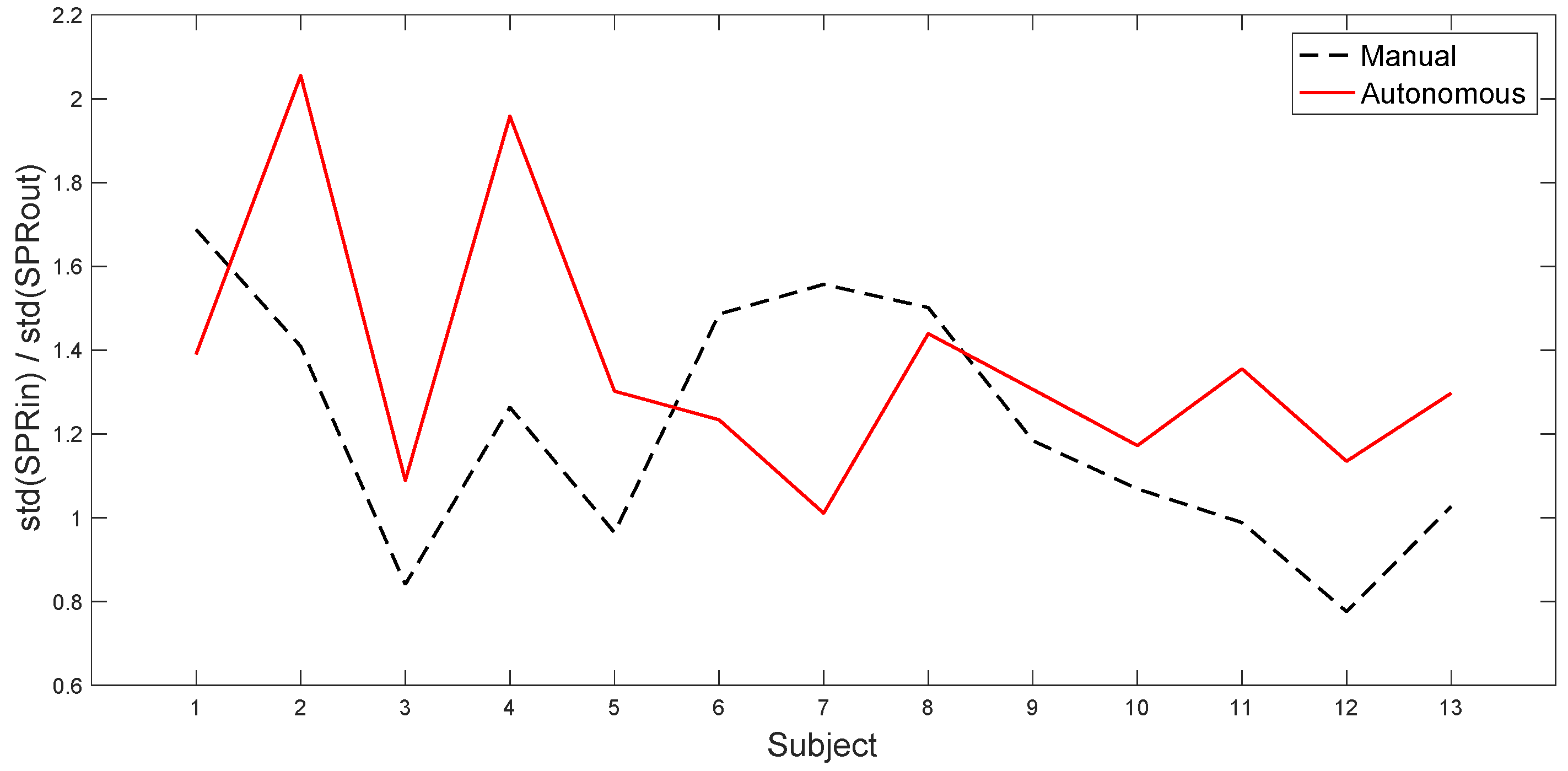
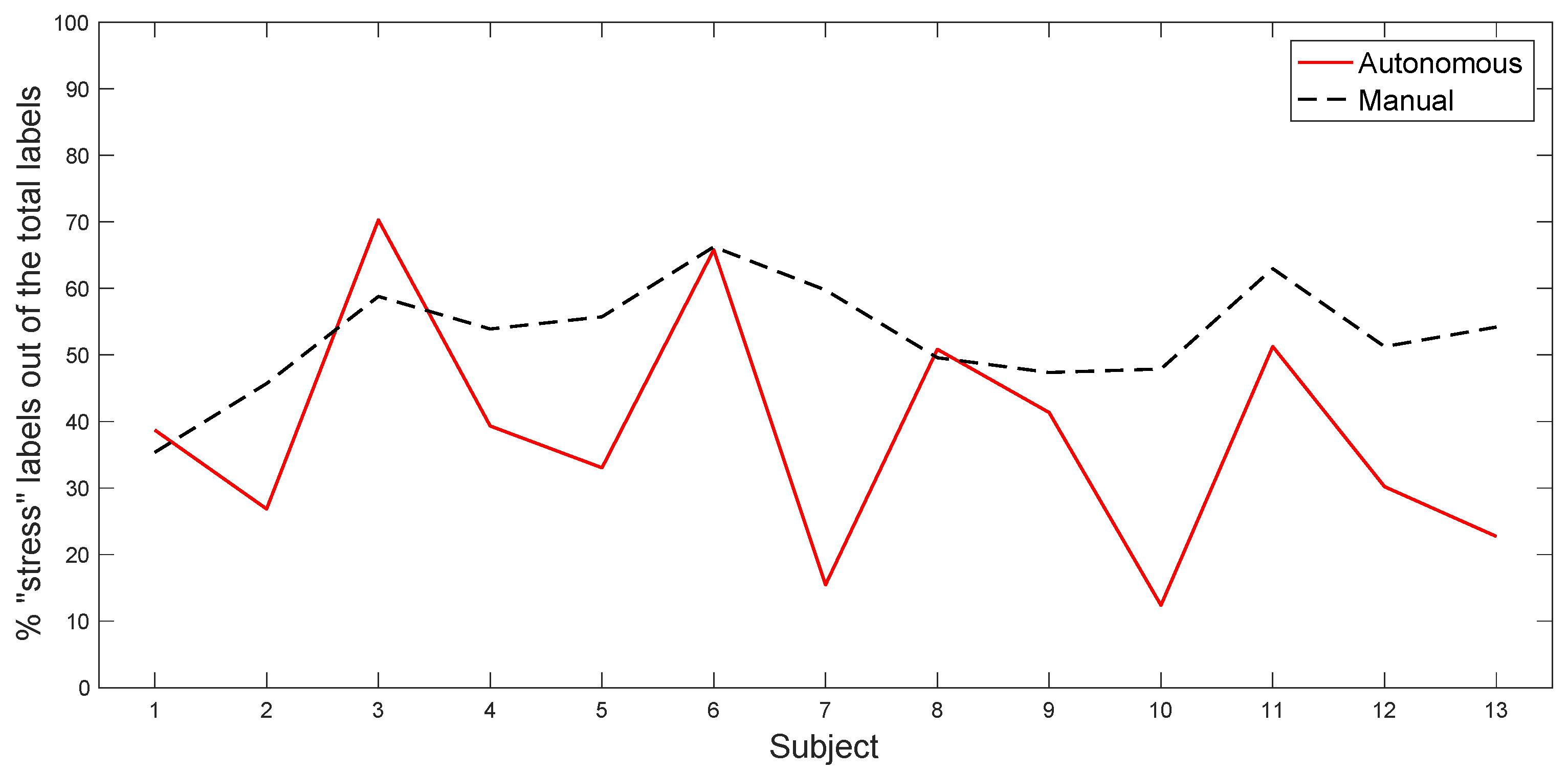

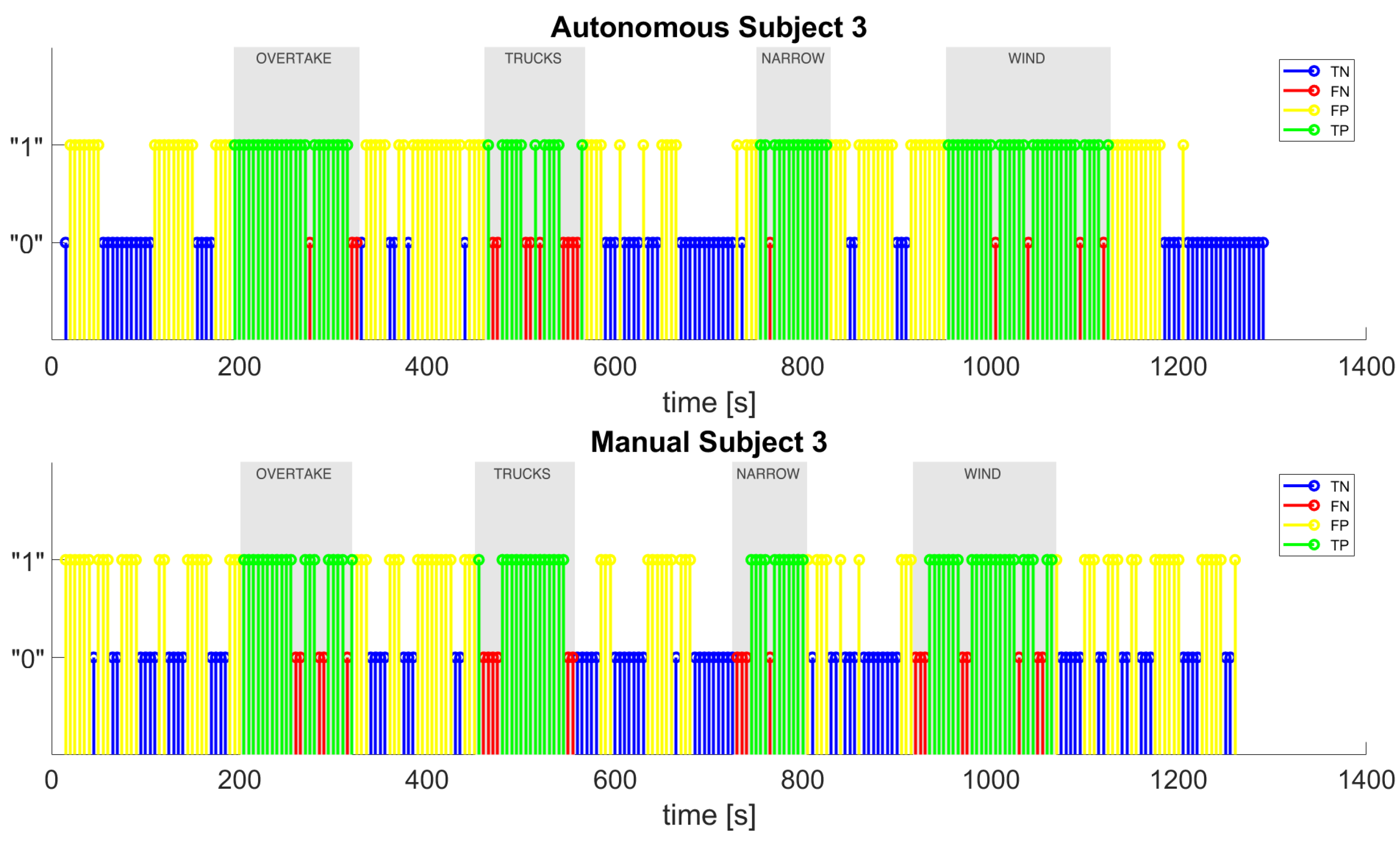
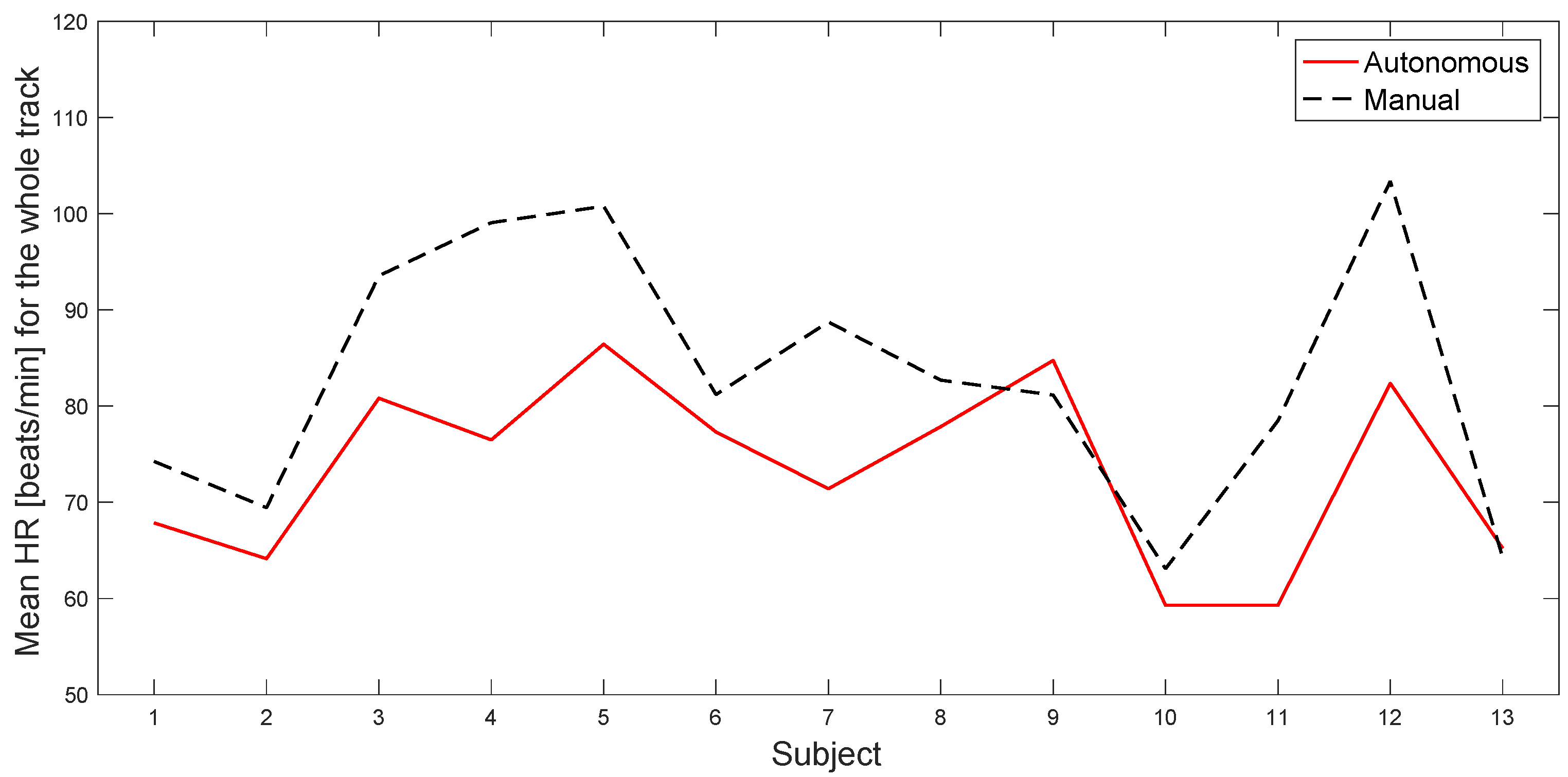
| Input Signal | Selected Features |
|---|---|
| SPR Signal | Variance |
| Energy | |
| Mean absolute value | |
| Mean absolute derivative | |
| Max absolute derivative |
| Manual | ||||||||||||||
|---|---|---|---|---|---|---|---|---|---|---|---|---|---|---|
| Subject | 1 | 2 | 3 | 4 | 5 | 6 | 7 | 8 | 9 | 10 | 11 | 12 | 13 | Mean |
| 35.37 | 45.71 | 58.80 | 53.91 | 55.74 | 66.25 | 59.76 | 49.59 | 47.37 | 47.90 | 62.98 | 51.26 | 54.20 | 52.99 | |
| Autonomous | ||||||||||||||
| Subject | 1 | 2 | 3 | 4 | 5 | 6 | 7 | 8 | 9 | 10 | 11 | 12 | 13 | Mean |
| 38.72 | 26.86 | 70.29 | 39.33 | 33.05 | 65.81 | 15.48 | 50.85 | 41.35 | 12.39 | 51.27 | 30.21 | 22.73 | 38.34 | |
| Manual | ||||||||||||||
|---|---|---|---|---|---|---|---|---|---|---|---|---|---|---|
| Subject | 1 | 2 | 3 | 4 | 5 | 6 | 7 | 8 | 9 | 10 | 11 | 12 | 13 | Mean (bpm) |
| task 1 | 75.96 | 73.64 | 100.17 | 109.08 | 108.23 | 83.11 | 97.41 | 85.98 | 79.80 | 63.29 | 79.60 | 99.34 | 64.08 | 86.13 |
| task 2 | 76.11 | 74.08 | 99.04 | 110.09 | 108.78 | 83.45 | 97.19 | 128 | 85.20 | 79.97 | 79.69 | 100.58 | 64.22 | 86.28 |
| task 4 | 76.63 | 74.43 | 100.04 | 109.84 | 109.13 | 83.39 | 97.58 | 85.98 | 79.98 | 63.06 | 80.16 | 100.09 | 64.10 | 86.49 |
| task 4 | 76.12 | 74.02 | 99.21 | 109.68 | 108.62 | 83.35 | 97.23 | 85.35 | 79.98 | 63.21 | 79.69 | 100.41 | 64.05 | 86.22 |
| no tasks | 74.10 | 68.98 | 92.80 | 97.83 | 99.92 | 80.97 | 87.72 | 82.38 | 81.33 | 63.07 | 78.40 | 103.83 | 64.29 | 82.74 |
| whole track | 74.25 | 69.44 | 93.55 | 99.07 | 100.78 | 81.20 | 88.75 | 82.70 | 81.15 | 63.09 | 78.48 | 103.38 | 64.27 | 83.09 |
| Autonomous | ||||||||||||||
| Subject | 1 | 2 | 3 | 4 | 5 | 6 | 7 | 8 | 9 | 10 | 11 | 12 | 13 | Mean (bpm) |
| task 1 | 66.64 | 65.89 | 81.10 | 77.92 | 86.81 | 78.29 | 73.91 | 74.99 | 81.55 | 60.66 | 82.03 | 81.58 | 64.26 | 75.05 |
| task 2 | 66.47 | 65.98 | 81.29 | 77.75 | 86.66 | 78.50 | 73.84 | 74.96 | 81.79 | 60.80 | 81.96 | 81.89 | 64.32 | 75.09 |
| task 3 | 66.49 | 65.98 | 81.29 | 77.78 | 86.68 | 78.48 | 73.85 | 74.96 | 81.76 | 60.79 | 81.98 | 81.87 | 64.34 | 75.10 |
| task 4 | 66.64 | 65.89 | 81.08 | 77.90 | 86.81 | 78.29 | 73.93 | 74.99 | 81.53 | 60.64 | 82.02 | 81.56 | 64.25 | 75.04 |
| no tasks | 68.02 | 63.96 | 80.78 | 76.33 | 86.40 | 77.19 | 71.11 | 78.24 | 85.12 | 59.11 | 85.95 | 82.44 | 65.32 | 75.38 |
| whole track | 67.86 | 64.14 | 80.82 | 76.49 | 86.44 | 77.31 | 71.41 | 77.87 | 84.75 | 59.29 | 85.52 | 82.37 | 65.22 | 75.35 |
© 2020 by the authors. Licensee MDPI, Basel, Switzerland. This article is an open access article distributed under the terms and conditions of the Creative Commons Attribution (CC BY) license (http://creativecommons.org/licenses/by/4.0/).
Share and Cite
Zontone, P.; Affanni, A.; Bernardini, R.; Del Linz, L.; Piras, A.; Rinaldo, R. Stress Evaluation in Simulated Autonomous and Manual Driving through the Analysis of Skin Potential Response and Electrocardiogram Signals. Sensors 2020, 20, 2494. https://doi.org/10.3390/s20092494
Zontone P, Affanni A, Bernardini R, Del Linz L, Piras A, Rinaldo R. Stress Evaluation in Simulated Autonomous and Manual Driving through the Analysis of Skin Potential Response and Electrocardiogram Signals. Sensors. 2020; 20(9):2494. https://doi.org/10.3390/s20092494
Chicago/Turabian StyleZontone, Pamela, Antonio Affanni, Riccardo Bernardini, Leonida Del Linz, Alessandro Piras, and Roberto Rinaldo. 2020. "Stress Evaluation in Simulated Autonomous and Manual Driving through the Analysis of Skin Potential Response and Electrocardiogram Signals" Sensors 20, no. 9: 2494. https://doi.org/10.3390/s20092494
APA StyleZontone, P., Affanni, A., Bernardini, R., Del Linz, L., Piras, A., & Rinaldo, R. (2020). Stress Evaluation in Simulated Autonomous and Manual Driving through the Analysis of Skin Potential Response and Electrocardiogram Signals. Sensors, 20(9), 2494. https://doi.org/10.3390/s20092494







